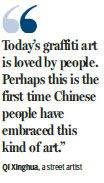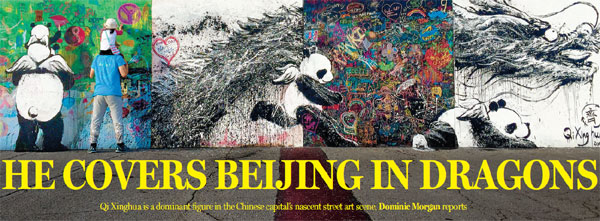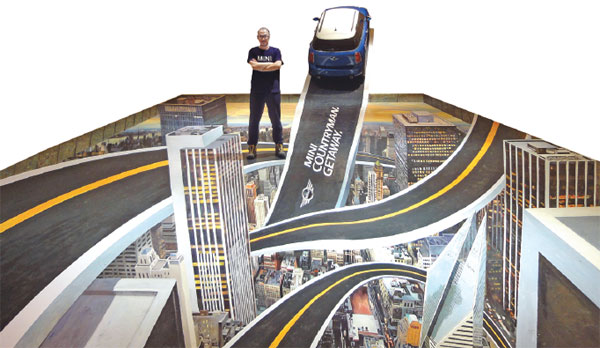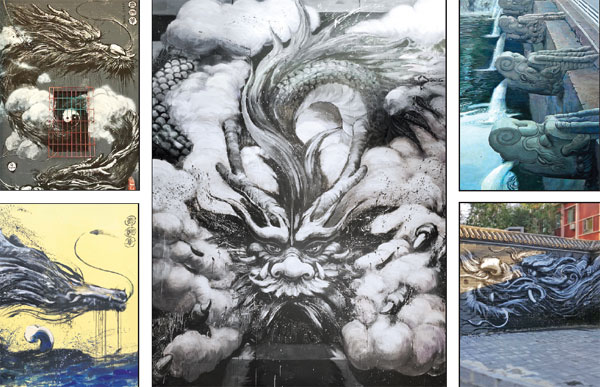He covers beijing in dragons
Qi Xinghua is a dominant figure in the Chinese capital's nascent street art scene, Dominic Morgan reports
'I think there is a close connection between me and the dragons," says Qi Xinghua, smiling shyly.
Looking around the street artist's Beijing studio, that is clear to see. A dozen of his trademark shaggy dragons are swooping across the huge canvases covering the concrete floor, while another gazes somberly into the distance from an easel by the sofa. Yet another stares out from Qi's black T-shirt.
Like the British street artist Banksy and his rats, dragons have become Qi's calling card since he emerged as the dominant figure in Beijing's nascent street art scene earlier this year.
The 34-year-old has sprayed eight dragons on walls around Beijing so far, and he recently declared his intention to cover the Chinese capital with a hundred of his hairy serpents over the coming months.
These few works have been an immediate hit with Chinese netizens, with Qi's posts about his latest works regularly amassing thousands of likes and hundreds of comments on Weibo, the Chinese microblogging site.

Interviews with The Wall Street Journal, Guardian and Global Times soon followed, and the label "China's Banksy" has already been applied to him more than once.
Qi's stratospheric rise is all the more amazing when you consider that until March, he had never sprayed on Beijing's streets before. He had never even considered it as a possibility.
A chance conversation with a graffiti writer in Dubai this February provided him with the light bulb moment.
"Before, I thought that graffiti was permitted in other countries. I thought the environment in China for graffiti was very unfriendly, but then I realized that it is actually very friendly compared to many countries," Qi tells China Daily.
That was all the encouragement Qi needed, and before long his works were popping up around Chaoyang district on a regular basis.
Much like his British counterpart, Qi's work often has a playful feel to it, his paintings incorporating the urban environment around them to allow viewers to see the city with fresh eyes.
Crumbling brickwork is transformed into a crocodile; a demolition notice sprayed onto a local building becomes a Street Fighter-style fireball thrown by a kneeling panda.
"Nature gives me a difficult question, and my work offers a humorous answer," Qi explained in one Weibo post.
But here the similarities with Banksy largely end. Though Qi professes himself to be an admirer of the self-styled vandal's work, he is the product of a very different world from the macho, aggressive British graffiti scene.

Far from being an artistic outsider, Qi graduated from the prestigious China Central Academy of Fine Arts in Beijing, just a few minutes' drive from his basement studio, in 2005.
Refreshingly, he makes no attempt to disguise his familiarity with high art, happily comparing his new focus on street art to the transition from modernism to postmodernism in Western painting.
However, Qi insists that he has always been a man of the people, preferring to create art for the street rather than a studio because "street art is for everyone, it aims to be accessible."
And though he received an elite education, he had far from a privileged upbringing. He grew up in the remote northeastern province of Heilongjiang, only moving to Beijing after winning a place at the academy.
It was soon after beginning his studies at the academy that Qi discovered the work of the artist who would change his life. A teacher showed Qi and his classmates images of some 3-D sidewalk chalk art by Julien Beever, and he was transfixed by it.
"We had never seen anything like that art form in China before. We thought it was unimaginable," he says.
For the next 10 years, Qi devoted himself to mastering the reverse-perspective style able to create the mind-bending optical illusions of 3-D art, and he began to take the form to a new level in terms of scale and ambition.
From 2010 to 2011, Qi broke the Guinness World Record for the largest 3-D mural four times, his enormous works reportedly inducing vertigo in some viewers.

But despite his success, Qi began to feel increasingly frustrated by the limitations of 3-D art's technical and rather formalistic style.
"The 3-D works gave full play to my ability, but they didn't allow me to express my feelings. This year, I realized I needed a change," he says.
His encounter with the graffiti writer at an exhibition in Dubai provided him with the inspiration he had been looking for.
If Qi was initially worried about potential brushes with the law at the start of his street art career, he had little need to be.
Compared with most Western countries, where graffiti writers often run the risk of prison time if they are caught, China is remarkably lenient.
As shown in Lance Crayon's excellent documentary Spray Paint Beijing, detained street artists in China are rarely given more than a night in jail and a fine of a few hundred yuan, the equivalent of less than a hundred dollars.
Qi has donned a hoodie and hit the streets late at night to complete a work a few times, but often he paints for hours in the middle of the day and has never got into trouble.
He has been spotted by urban patrol officials, chengguan, while spraying a few times, he says. "But usually they are just very interested in my painting and ask me questions about it."
Qi ascribes the chengguans' reaction partly to the nature of street art itself.
"Street art works display a love for the world," he says passionately. "It is different from graffiti, which doesn't consider its interaction with the environment. Street art is delicately created for a specific place."
This is certainly true of Qi, who gives an extraordinary amount of thought to how his work will be received by the community. Far from being a reclusive rebel like Banksy, in spirit he is much closer to the street performer Beever, even taking requests from passers-by.
Right now, he confesses, he is having some trouble with his dragons. "In the past, I have always painted my dragons black and white," he says. "But people keep asking me, why don't you paint with more color? It seems to be a requirement of the general public. So, I have been studying ways to add more color."
This dedication is partly cultural. "Chinese philosophy is humble. As I listen to people's advice, I get better, just like I take inspiration from the great masters," he says, before adding with a laugh. "But I don't take all the advice! If it's bad advice, I ignore it."
However, another reason Qi feels compelled to listen to the community is that he feels he should act as an ambassador for street art in China.
"I feel like my street work has more significance (than my 3-D work), because it may be able to change people's opinion of street art," he says.
"Street art has just 10 years' history in China; it is difficult for the general public to understand. But today it is getting huge media attention. Today's graffiti art is loved by people. Perhaps this is the first time Chinese people have embraced this kind of art," he adds.
But despite street art's increasing popularity in China, Qi worries that this will not lead to more youngsters picking up a spray can.
"Young people in China are very different (to those in the West)," he states. "Chinese youngsters are more focused on money. If they find out they can't make money from street art, they will think it is useless, hopeless."
Although, he makes clear, this is not really a cultural difference, but a result of factors that will be familiar to residents in New York and London.
"Rent is expensive in Beijing: Just one room is 5,000 yuan ($725). Young people aren't willing to invest time in something that won't make them much money," he sighs. "And in China, if you don't work, you don't get health insurance."
Even if Spray Paint Beijing's prediction that China will soon become a global center for street art does not come to pass, Qi is determined to represent his country on the international stage.
"Right now, I am working on creating Chinese 3-D paintings," he reveals, gesturing toward the huge canvases spread across the floor.
These sweeping landscapes of misty mountains are strikingly traditional: Qi has even tacked up a set of classical paintings on the wall to refer to while he is working.
"All over the world, there is only Western 3-D painting. I want to create a Chinese 3-D painting language," he explains proudly, adding that his street work is also part of the same effort.
"They are not actually 3-D, but they produce a 3-D effect on the spirit," he clarifies.
This is also partly the reason for his focus on dragons. "Chinese people believe we are the children of dragons," he states. "In China, the dragon has an uncertain image. Its image is always changing. In artistic creation, there is lots of freedom."
But there is also a much more personal reason behind his choice of subject. "My nickname was 'Black Dragon' when I was younger; I was born in the year of the dragon," he reveals. "I hope that my dragons can accompany my daughter as she grows older."
Contact the writer at dominic_m@chinadaily.com.cn
|
Top: Qi Xinghua's work Collision at the Sarasota Chalk Festival in Florida. Above: A dozen of Qi's trademark shaggy dragons are swooping across the huge canvases covering Beijing's concrete walls. Below: Qi poses for a photo shoot with his work City Big Bang at the Pacific Place in Hong Kong. Photos Provided To China Daily |
(China Daily 01/02/2017 page7)

















